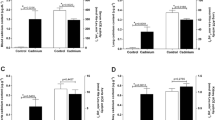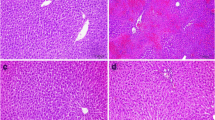Abstract
The effect of cadmium on the renal lysozyme level was examined by injecting male albino rabbits subcutaneously with 1 mg cadmium/kg body weight three times a week for 1 or 3 months. The lysozyme level in the renal brush border membrane of the cadmium-treated animals was elevated ten-fold. The lysozyme activity in the liver and small intestine tissue homogenates of rabbits was elevated by a 1-month treatment with cadmium, markedly elevated in the kidney, but markedly reduced in the spleen and lungs. Exposure to cadmium for 3 months produced an essentially similar effect on the enzyme level in the tissue, except for the lungs in which the lysozyme level returned to the preinjection level. This marked increase in the lysozyme level in the kidney of cadmium-treated rabbits was confirmed by an indirect immunofluorescent antibody technique. In control animals, intracellular distribution of the enzyme was selectively distributed to only a small number of proximal tubules, with none distributed in the medulla or glomerulus. However, after expose to cadmium, the renal tubules showed strongly positive lysozyme staining. In addition to an increase in intensity of the specific fluorescence, this enzyme was widely distributed not only in the proximal convoluted portion, but also in the straight portion of the proximal tubules, which essentially showed no enzyme activity under normal conditions. The enzyme in these cells was evenly distributed throughout the cytoplasm. The plasma lysozyme level increased immediately after the administration of cadmium, and detectable amounts of the enzyme began to appear in urine from the 3rd week after the first injection, with a 1-week lag after the maximum level of lysozyme in the plasma. This high level of plasma lysozyme, varied two-to fourfold over the control, and lysozymuria continued throughout the experiment. The concentration of cadmium in the renal cortex was 141 μg/g wet tissue at 1 month, and 208 μg at 3 months. In conclusion, the cadmium-induced enhancement of the lysozyme level in the renal cortex may be due primarily to the elevation of the lysozyme level in plasma by cadmium. The enzymatic high net positive charge, characteristic of lysozyme, may contribute greatly to this mechanism. In addition, the excretion of a large amount of lysozyme into the urine observed in a later stage may be due to the concomitant occurrence of leakage from the destroyed tubular cells and reduced tubular reabsorption of filtered enzyme, whereas lysozymuria at an early stage may be solely due to excess amounts of plasma lysozyme.
Similar content being viewed by others
Abbreviations
- SDS:
-
Sodium dodesyl sulfate
- PAGE:
-
Polyacrylamide gel electrophoresis
- IEF:
-
Isoelectric focusing
- PBS:
-
0.01 M Sodium phosphate buffer pH 7.2, 0.15 M NaCl
- FITC:
-
Fluorescein isothiocyanate
- AMP:
-
Adenosine 5′-monophosphate
- PAS:
-
Periodic acid/Schiff reagent
References
Asamer H, Schmalzl F, Braunsteiner H (1969) Der immunzytologische Lysozymnachweis in menschlichen Blutzellen. Acta Haematol 41: 49–54
Balazs T, Roepke RR (1966) Lysozymuria induced in rats by nephrotoxic agents. Proc Soc Exp Biol Med 123: 380–385
Bernard AM, Lauwerys RR (1981) Retinol binding protein in urine: A more practical index than urinary β2-microglobulin for the routine screening of renal tubular function. Clin Chem 27: 1781–1782
Bernard AM, Lauwerys RR, Starace V, Masson PL (1980) Isolation of a new low molecular weight β2-globulin from urine of a worker with chronic cadmium poisoning. Biochem Biophys Res Commun 93: 535–543
Briggs RS, Perillie PE, Finch SC (1966) Lysozyme in bone marrow and peripheral blood cells. J Histochem Cytochem 14: 167–170
Cappuccino JG, Winston S, Perri GC (1964) Muramidase activity of kidney and spleen in Swiss mice challenged with B.C.G., zymosan and bacterial endotoxins. Proc Soc Exp Biol Med 116: 869–872
Catovsky D, Galton DAG, Griffin C (1971) The significance of lysozyme estimations in acute myeloid and chronic monocytic leukaemia. Br J Haematol 21: 565–580
Christensen EI, Maunsbach AS (1974) Intralysosomal digestion of lysozyme in renal proximal tubule cells. Kidney Int 6: 396–407
Davis JS, Flynn FV, Platt HS (1968) The characterisation of urine protein by gel filtration. Clin Chim Acta 21: 357–376
Dierickx PJ (1981) Urinary gamma-glutamyl transferase as an indicator of acute nephrotoxicity in rats. Arch Toxicol 47: 209–215
Friberg L (1950) Health hazards in the manufacture of alkaline accumulators with special reference to chronic cadmium poisoning. Acta Med Scand, Suppl. 240: 1–124
Friberg L, Piscator M, Nordberg GF, Kjellström T (1974) In: Friberg L, Piscator M, Nordberg GF, Kjellström T (eds) Cadmium in the Environment, Second edition. CRC Press, Inc. Ohio, p 208 (translated into Japanese)
Fyhrquist FY, Klockars M, Gordin A, Törnroth T, Kock B (1980) Hyperreninemia, lysozymuria, and erythrocytosis in Fanconi syndrome with medullary cystic kidney. Acta Med Scand 207: 359–365
Glossmann H, Neville Jr DM (1971) Glycoproteins of cell surfaces. J Biol Chem 246: 6339–6346
Goldbarg JA, Rutenburg AM (1958) The colorimetric determination of leucine aminopeptidase in urine and serum of normal subjects and patients with cancer and other diseases. Cancer 11: 238–291
Harrison JF, Lunt GS, Scott P, Blainey JD (1968) Urinary lysozyme, ribonuclease, and low-molecular-weight protein in renal disease. Lancet i, 371–374
Hatefi Y (1978) Resolution of complex II and isolation of succinate dehydrogenase (EC 1.3.99.1). Methods Enzymol 53: 34–35
Hayslett JP, Perillie PE, Finch SC (1968) Urinary muramidase and renal disease. Correlation with renal histology and implication for the mechanism of enzymuria. New Engl J Med 279: 506–512
Hodges TK, Leonard RJ (1974) Purification of a plasma membrane-bound adenosine triphosphatase from plant roots. Methods Enzymol 32: 397–398
Houser M (1983) Improved turbidimetric assay for lysozyme in urine. Clin Chem 29: 1488–1493
Just M, Harbermann E (1977) The renal handling of polybasic drugs 2. In vitro studies with brush border and lysosomal preparations. Naunyn-Schmiedeberg's Arch Pharmacol 300: 67–76
Klockars M, Osserman EF (1974) Localization of lysozyme in normal rat tissues by an immunoperoxidase method. J Histochem Cytochem 22: 139–146
Lloyd JB, Whelan WJ (1969) An improved method for enzymic determination of glucose in the presence of maltose. Anal Biochem 30: 467–470
Lowry OH, Rosebrough NJ, Farr AL, Randall RJ (1951) Protein measurement with the Folin phenol reagent. J Biol Chem 193: 265–275
Maack T (1967) Changes in the activity of acid hydrolases during renal reabsorption of lysozyme. J Cell Biol 35: 268–273
Maack T, Mackensie DDS, Kinter WB (1971) Intracellular pathways of renal reabsorption of lysozyme. Am J Physiol 221: 1609–1616
Madsen KM, Christensen EI (1978) Effects of mercury on lysosomal protein digestion in the kidney proximal tubule. Lab Invest 38: 165–174
Malathi P, Preiser H, Fairclough P, Mallett P, Crane RK (1979) A rapid method for the isolation of kidney brush border membranes. Biochem Biophys Acta 554: 259–263
Mason DY, Taylor CR (1975) The distribution of muramidase (lysozyme) in human tissues. J Clin Pathol 28: 124–132
Mego JL, Barnes J (1973) Inhibition of heterolysosome formation and function in mouse kidneys by injection of mercuric chloride. Biochem Pharmacol 22: 373–381
Mego JL, Cain JA (1975) An effect of cadmium on heterolysosome formation and function in mice. Biochem Pharmacol 24: 1227–1232
Mogensen CE, Sølling K (1977) Studies on renal tubular protein reabsorption: partial and near complete inhibition by certain amino acids. Scand J Clin Lab Invest 37: 477–486
Nagai Y, Sato M, Sasaki M (1982) Effect of cadmium administration upon urinary excretion of hydroxylysine and hydroxylproline in the rat. Toxicol Appl Pharmacol 63: 188–193
Nathan N, Ariso JR, Touster O (1974) Isolation of rat liver plasma membrane fragments in isotonic sucrose. Methods Enzymol 31: 92
Ngaha EO, Madusolumuo MA (1982) Renal effects of an aminoglycoside antibiotic in the rat. Toxicol Lett 13: 23–27
Nishimura N, Oshima H, Nakano M (1986) Urinary trehalase as an early indicator of cadmium-induced renal tubular damage in rabbit. Arch Toxicol 59: 255–260
Nishizumi M (1972) Electron microscopic study of cadmium nephrotoxicity in the rat. Arch Environ Health 24: 215–225
Nomiyama K, Sato C, Yamamoto A (1973) Early signs of cadmium intoxication in rabbits. Toxicol Appl Pharmacol 24: 625–635
Nomiyama K, Yamamoto A, Sato C (1974) Assay of urinary enzymes in toxic nephropathy. Toxicol Appl Pharmacol 27: 484–490
Nomiyama K, Sugata Y, Yamamoto A, Nomiyama H (1975) Effects of dietary cadmium on rabbits. 1. Early signs of cadmium intoxication. Toxicol Appl Pharmacol 31: 4–12
Nomiyama K, Nomiyama H, Yotoriyama M, Matsui K (1982) Sodium dodecyl sulfate acrylamide gel electrophoretic studies on low-molecular-weight proteinuria, an early sign of cadmium health effects, in rabbits. Indust Health 20: 11–18
O'Farrell PH (1975) High resolution two-dimensional electrophoresis of proteins. J Biol Chem 250: 4007–4021
Ottosen PD, Bode F, Madsen KM, Maunsbach AB (1979) Renal handling of lysozyme in the rat. Kidney Int 15: 246–254
Perillie PE, Kaplan SS, Lefkowitz E, Rogaway W, Finch SC (1968) Studies of muramidase (lysozyme) in leukemia. JAMA 203: 317–322
Perri GC, Faulk M, Shapiro E, Money WL (1963) Role of the kidney in accumulation of egg white muramidase in experimental animals. Proc Soc Biol Med 115: 189–192
Piscator M, Axelsson B (1970) Serum proteins and kidney function after exposure to cadmium. Arch Environ Health 21: 604–608
Plaice CHJ (1961) A note on the determination of serum beta-glucuronidase activity. J Clin Pathol 14: 661–665
Prockop DJ, Davidson WD (1964) A study of urinary and serum lysozyme in patients with renal disease. New Engl J Med 270: 269–274
Skaikh ZA, Smith JC (1976) The biosynthesis of metallothionein in rat liver and kidney after administration of cadmium. Chem Biol Interact 15: 327–336
Speece AJ (1963) Histochemical distribution of lysozyme activity in organs of normal mice and radiation chimeras. J Histochem Cytochem 12: 384–391
Stefanini M, De Martino C, Zamboni L (1967) Fixation of ejaculated spermatozoa for electron microscopy. Nature 216: 173–174
Stowe HD, Wilson M, Goyer RA (1972) Clinical and morphologic effects of oral cadmium toxicity in rabbits. Arch Pathol 94: 389–405
Sugihara N, Tohyama C, Murakami M, Saito H (1986) Significance of increase in urinary metallothionein of rats repeatedly exposed to cadmium. Toxicology 41: 1–9
Sutton JS, Weiss L (1966) Transformation of monocytes in tissue culture into macrophages, epithelioid cells, and multinucleated giant cells an electron microscope study. J Cell Biol 28: 303–332
Towbin H, Staehelin T, Gordon J (1979) Electrophoretic transfer of proteins from polyacrylamide gels to nitrocellulose sheets: Procedure and some applications. Proc Natl Acad Sci USA 76: 4350–4354
Webb M (1979) The metallothioneins. In: Webb M (ed) The chemistry, biochemistry and biology of cadmium. Elsevier/ North-Holland, Amsterdam, pp 195–255
Wiernik PM, Serpick AA (1969) Clinical significance of serum and urinary muramidase activity in leukemia and other hematologic malignancies. Am J Med 46: 330–343
Wright PJ, Leathwood PD, Plummer DT (1972a) Enzymes in rat urine: acid-phosphatase. Enzymologia 42: 459–468
Wright PJ, Leathwood PD, Plummer DT (1972b) Enzymes in rat urine: alkaline phosphatase. Enzymologia 42: 317–327
Author information
Authors and Affiliations
Rights and permissions
About this article
Cite this article
Nishimura, N. The mechanism of cadmium-induced lysozyme enhancement in rabbit kidney. Arch Toxicol 61, 105–115 (1987). https://doi.org/10.1007/BF00661367
Received:
Accepted:
Issue Date:
DOI: https://doi.org/10.1007/BF00661367




